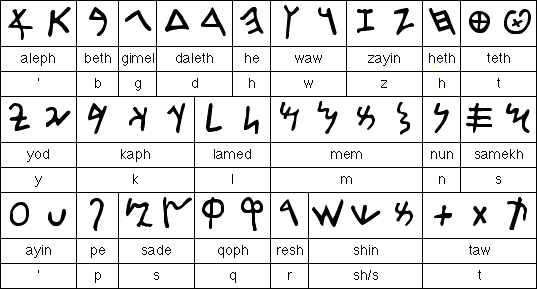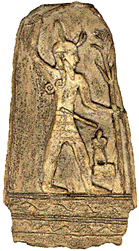Phoenicia (foh-NEE-shee-ah) Phoenicia is the Greek name for the country and
people living on the coast of Syria in ancient times at the east end of the
Mediterranean Sea. It is believed that economic opportunity and population
pressures forced them out into the seas. The Phoenicians colonized many areas
along the Mediterranean Sea. Areas where their colonies have been found:
Sardinia Cyprus, and Carthage-most important and lasting colony By far they
were superior to all peoples of that time in seamanship. Legend has it that an
Egyptian
pharaoh hired a band of Phoenicians to map and circumnavigate the
coast of Africa. They are best remembered for their contributions in the
establishment to trade with the many peoples living along the Mediterranean
Sea. The Greeks received their alphabet from them as late as the 10th century
B.C. or as early as the 15th. Other antiquities famed to the Phoenicians include
carved ivories to be used in furniture, metalwork, and especially glassware.
|
|
THE PHOENICIANS ROUTES OF THE PHOENICIANS The Fertile
Crescent is roughly an arc-shaped area which stretches from the mouth of the
Tigris and Euphrates rivers at the Persian Gulf, west to the Red Sea. About
5,000 years ago it was inhabited by a race know as Semites. The Semites who
lived in the eastern portion of the Fertile Crescent were Sumerians, Assyrians,
and Babylonians. In the western portion lived the Amorites. Those Amorites
who settled in what are today Lebanon, Syria, and Israel were know as
Canaanites. Later, the Greek called them Phoenicians.
|
|
PHOENICIANS IN HISTORY There is no doubt the Phoenicians were
among the most interesting people in history. Because they left so few written
records of their own achievements, their history has been pieced together from
records of all the other nations with which they came in contact, either through
trade or through battle. Other information has been gathered from the work of
archaeologists whose digging have unearthed tombs of their rulers or what little
is left of their cities.
|
|

The Phoenician Alphabet. |
|
THE OLDEST CITY IN THE WORLD Archaeologists have uncovered
homes of farmers and fishermen in Gebeil dating back to 7000 B.C. They found
one-room huts with crushed limestone floors and stone idol of god El. Because
of these discoveries, it is thought that Gebeil (later known as Byblos) may
actually be the oldest city in the world.
TIES WITH EGYPT As far as back as 3200 B.C., the people of Gebeil
(Byblos) were cutting down cedar trees in the mountains of Lebanon, to be
shipped to Egypt and Mesopotamia for use in building ships and making
columns for houses. In return, the Phoenicians brought back gold, copper, and
turquoise from the Nile Valley and Sinai. Canaanite ceramic pieces have been
found in Egyptian tombs dating back to 2999 B.C. In 1954, archaeologists
found Cheops (khufu) at Giza. Cheops lived around 2550 B.C. The barge was
made of Lebanese cedar wood and faint scent of the cedar was still in the grain
at the time of its discovery.
|
|
THE ALPHABET Sumerian cuneiforms (wedge shaped symbols in clay
tablets) and Egyptian hieroglyphics (pictographs) were the only known forms of
writing before the alphabet as we know it was developed. Both scripts, though
separately created, used picture writing. Eventually, pictures or signs
represented sounds. Finally, the pictures became so simplified that a whole
word was written as a single sign. By about 1200 B.C., the Phoenicians had
developed symbols which in time became a real alphabet. The Phoenician
alphabet consisted of twenty-two symbols, all consonants. Each one
represented its own sound. The Egyptian symbol for the
ox head was given the
Semitic name aleph and was sounded as "a." The symbol for house became
Beth and was sounded as "b." It is easily see how the Phoenician alphabet was
used to form the other alphabets which followed it. Aleph became the Greek
alpha,
Beth became beta. In time, these letters became the Roman letters A and
B and eventually the English A and B, and so on for the entire alphabet. Once a
written language was established, it was inscribed on Egyptian papyrus, a type
of paper made of reeds. So, closely linked with papyrus with the city of Byblos
(which traded cedar for the paper) that when the writing of the Hebrew
prophets were translated into Greek the city's name was given to the great book
- the Bible. Because the papyrus rotted away in the damp sea air and soil, there
are practically no Phoenician writings left. Thus, the literature of the people
who influenced the western world in her writing has largely vanished. Still,
because Egyptian scribes copied the Phoenician letters after hieroglyphics were
no longer used, and because artists in Ninevah inscribed them in stone, the
alphabet remains with us. Alphabet |
|
THE CITY-STATES For the next three centuries, independent Phoenicia
reached its height as a nation whose prime interests were trade, the arts, and
religion. Organized into individual city-states, each Phoenician city was under
its own form of government. Each had its own god and its own ruler, whose
usually remained in power for life. Gebeil (Byblos) was a strong religious
city-state. Sidon and tyre were cities of Business, industry, and navigation. The
city-states were all linked by their common ancestors, language, and writing.
Their mutual interests were their trade arrangements, their customs, and their
rituals and beliefs. Nevertheless, even though they were only a one or two day
march from each other, they never were able to unite as a single power when
they were attacked.
|
TYRE, THE PURPLE DYE CENTER Tyre was the major region for the
purple dye industry, which probably began as early as the 18th century B.C.
The dye was carefully extracted, a few drops at a time from the murex, a
shell-fish found in the waters off of Tyre and sidon. The process used to extract
the fluid was so difficult and so expensive that only the rich could afford to buy
the dyed fabric. It is because of this Phoenician fabric that we still use the
expression "born in the purple" to mean one who is born rich.
|
|
ON THE SEA The Mediterranean Sea allowed the Phoenicians to wander, to
explore, and to discover. It was their link to a world that awaited their skill and
their art. These fine merchants brought their dye, fabric, ceramics, glass, metals,
wine, crops, and oil from port to port. They became the world's finest maritime
nation. The Phoenicians were not only adventurous merchants but expert
sailors and navigators as well. They colonized parts of Cyprus, Rhodes, and the
Aegean Islands. Phoenician sailors journeyed east to the Black Sea and west to
places such as Corinth, Thebes, Sardinia, Palermo, Marseille, Corsica, and
Malta. They were known to have gone as far as Gibraltar and Cadiz in Spain.
By about 1000 B.C., they had finally reached the Atlantic Ocean. The Greeks
were influenced in their navigation by the Phoenicians, who taught them to sail
by the North star. The Greeks have designs on their ships similar to those from
Phoenician models.
|
E-Mail: info@lebanon2000.com
![[INDEX]](images/2001Botom.jpg)
| Home Page | Arabic
News Stand |
Phoenicians | Boston | | Photo Gallery | Welcome
to Lebanon |
| Web Page Design |
Advertising | Tripoli |
Last Updated
12/23/14
Mediterranean, Civilization,
Religion, Archaeology, Museum, Christianity, Islam, Judaism, Church, Synagogue, Turkey,
Jordan, Antique, Ancient, City, Amphitheatre, Ottoman, Roman, Byzantine, Istanbul,
Constantinople, Catalhoyuk, Side, Miletus, Didyma, Ephesus, Mediterranean, Civilization,
Religion, Archaeology, Museum, Christianity, Islam, Judaism, Church, Synagogue, Turkey,
Jordan, Antique, Ancient, City, Amphitheatre, Ottoman, Roman, Byzantine, Istanbul,
Constantinople, Catalhoyuk, Side, Miletus, Didyma, Ephesus, Mediterranean, Civilization,
Religion, Archaeology, Museum, Christianity, Islam, Judaism, Church, Synagogue, Turkey,
Jordan, Antique, Ancient, City, Amphitheatre, Ottoman, Roman, Byzantine, Istanbul,
Constantinople, Catalhoyuk, Side, Miletus, Didyma, Ephesus, Mediterranean, Civilization,
Religion, Archaeology, Museum, Christianity, Islam, Judaism, Church, Synagogue, Turkey,
Jordan, Antique, Ancient, City, Amphitheatre, Ottoman, Roman, Byzantine, Istanbul,
Constantinople, Catalhoyuk, Side, Miletus, Didyma, Ephesus, Mediterranean, Civilization,
Religion, Archaeology, Museum, Christianity, Islam, Judaism, Church, Synagogue, Turkey,
Jordan, Antique, Ancient, City, Amphitheatre, Ottoman, Roman, Byzantine, Istanbul,
Constantinople, Catalhoyuk, Side, Miletus, Didyma, Ephesus, Mediterranean, ortakoy,
shapinuwa, Sapinuwa, Ortakoy.


